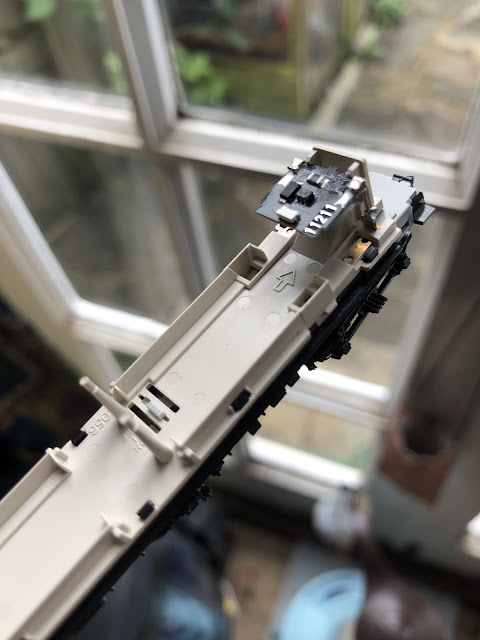This model was bought with a specific project in mind. Not having the space for anything serious, I thought about creating a Japanese-style layout on a circular piece of wood I'd come across in a charity shop. What I needed was a quaint railcar or EMU to run on it, something happy to go around a circle of track just 30 cm in diameter. Although not the most colourful train that Kato produce, this unit does the job and has some nice details and an old-fashioned look that make it a charming addition to the fleet.
Background
Built at various points during the late 1920s, these sets were ordered by the Ministry of Railways to replace older wooden-bodied units (the DeHa 63100 series). Although those units had worked well, building wooden bodies had become expensive after an earthquake increased demand for timber, and on top of that, wooden bodied cars didn't provide much protection for passengers during collisions.
The new railcars used standardised underframes and bogies. Steel plates were attached to the frame of the body using rivets, while additional strips of steel reinforced the plating around the windows. Additional ventilation was added to the roof, while curtains were added to the windows instead of shutters.
Maximum speed was 95 km/h. Seating was third-class throughout.
Kato 10-1345 KuMoHa 11 200-series
What's in the box?
- One powered car with pantograph and one unpowered trailer car
- Working headlights and taillights
- Sprue with assorted plastic parts such as cables and ATS gear
- Sticker sheet including train numbers and destination headcodes suitable for the Nambu branch and main lines, the Tsurumi line and the Ome line
On the one hand, the colour scheme isn't the most exciting. The seating inside the cars is plain off-white plastic looks very plain. As per the prototype, the seating runs longitudinally along the car, and other than these 'benches' there's really not much to see inside the cars. On the real things, the upholstery is blue, so painting them is certainly one possible upgrade. Adding some seated passengers, and a driver in the cab, would also make a big difference.
But on the other hand, the models themselves are cleverly designed and include some excellent features. Starting with the underframe detailing, there's a lot to see here, including all sorts of pipes and rods. The wheels are spoked and look very nice indeed.
The couplings are used are not Rapido couplings but adaptations of the classic Japanese Shibata coupler. These work well, but you can't easily join them together on very tight curves (such as 15 cm radius Unitrack). I ended up replacing them with home-made neodymium magnet couplers that do the job nicely on circular layouts. That aside, what's really impressive about the couplers is the 'kinematic' hinge they're attached to on the body, rather than the bogies. This clever device allows the couplings to swing freely, while being gently centring, keeping the cars quite close together even on tight bends.
Inside the power car there's a motor with two flywheels, connected via cardan shafts to both bogies. Electrical pick-up is via the pin-point bearings on all eight wheels of the power car. There are no traction tyres, but haulage is more than adequate for the two cars in the unit and a couple more unpowered cars if you wanted to add them (Kato #10-1347, Tsurumi Line 2-Car Extension Set).
On both cars, the body unclips to reveal a couple of extra goodies. One is a small switch for turning on and off the headlights and taillights. This is useful when coupling together two sets to make a four-car train: the lights on the inward-facing cabs would not normally be in use, so shouldn't really light up when the train is running.
The other useful fixture are the standard Kato lighting kit attachment slots. As always with installing these kits, the instructions are somewhat generalised so a certain amount of fettling may be required, but once installed, the results are worthwhile.
Conclusion
As the video above hopefully shows, this is a decent model that works astonishingly well even on ridiculously tight curves. The motor isn't quite as silent as some of the more recent ones used by Kato, but the noise it makes isn't obtrusive by any means.
While the styling and livery might best be described as workmanlike, as an 'old time' model this is a useful little train for suburban branchlines set anywhere between the 1920s and 1970s.





